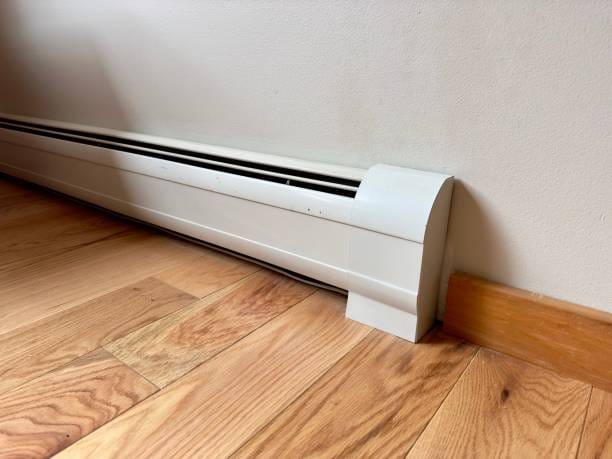As utilities continue to get more expensive and we get more and more concerned about our lifestyle’s impact on the environment, homeowners are being presented with more and more options for heating their homes. Most homes in the US still harness a furnace, pushing hot air through vents on your baseboards, but other options are gaining prominence at unprecedented rates. One such alternative is hot water baseboard heat. Harnessing a loop of heated water, baseboard radiators offer a great solution to keeping your home warm, but how do baseboard heaters work?
How Hot Water Baseboard Heat Works
While we might be used to heat coming from our baseboards, there are a few different types out there. Forced air circulates air heated from a furnace, electric heaters use small fan-assisted heaters and, as the name suggests, hot water heaters use heated water to warm your space.
Hot water baseboard heating makes use of a boiler (which can also supply hot water to your faucets and showers). From here, water is pumped around a closed loop, losing heat as it goes. As it cools, it continues around the loop until it reaches the boiler to be heated up again.
The radiators themselves consist of a series of fins, tucked away in the baseboard. These provide a wide surface area and allow the hot water to heat the air which then radiates around the room.
Components of a Baseboard Heating System
There are a few different designs of systems out there but they all have the same basic components:
- A boiler: this could be gas, oil or electrically powered. The boiler is where the heat is generated.
- Pipework: This will usually be either copper or PEX. These are very thin and snake between the boiler and baseboard radiators, creating the heating loop.
- Baseboard units: These are the radiators themselves. They consist of a series of thin fins which the water flows through. The fins create a wide surface area, allowing the heat to radiate out efficiently.
- Circulator pump: This is what forces the water through the system from and, eventually, back to the boiler.
- Thermostat: This allows you to control the temperature that the system will heat your space to.
Comparison to Other Common Heating Systems
Hot water baseboard heat compares well to the other baseboard-based heating systems that are so common in the US.
When compared to forced air, it’s quieter, offers a more even heat through the home and doesn’t push allergens and dust around.
It’s also cheaper and easier to install than underfloor heating (though it uses much the same principles). It is a little less even though.
Pros and Cons of Hot Water Baseboard Heating
Like any heating system, hot water based heating comes with a set of pros and cons. There’s always some compromise to be made with any method of heating and which lines are worth crossing will depend on your own tastes and needs.
Pros:
Let’s look at the upsides first:
Energy Efficiency
Water holds heat much better than air does. This means that, once it’s heated to the desired level, it requires a lot less energy to keep it there as it circulates.
Quiet Operation
While many of us find the quiet whoosh of air through the ducts quite comforting, hot water systems are much quieter. Thanks to a lack of blowers and fans, you might not hear anything at all. If there is a dripping or gurgling noise, bleeding the heaters is simple and should eliminate the sounds quickly.
Even Heating
Once the system has gotten up to temperature, the radiation will spread fairly evenly through a space. This means that there are no cold spots.
Improved Air Quality
Without ducts to collect dust and allergens and circulate them around your home, hot water systems have a lot less negative impact on air quality.
Zoning Capabilities
There’s no point in heating a space you’re not using- that’s literally burning money. Hot water baseboard heaters allow you to turn off the heat in empty spaces, offering savings and energy efficiency.
Cons:
While the pros column is pretty full, no system is perfect and there are a few downsides to consider before installing a new system.
Slower Heat Response
Hot water systems can be pretty slow to change the temperature in your room. They take time to heat and cool and this can take some adjusting to if you’re used to quicker and more responsive systems.
Require Unobstructed Space
While it’s not an insurmountable problem, radiant heating requires airflow around the space. This means you’ll be slightly limited with where you can place your furniture against the walls. A blocked heater won’t heat the room nearly as well.
Regular Maintenance Needs
Water always contains a certain amount of impurities and these can collect within the pipes in the form of sludge. It’s not a big deal to flush out the system but it does need to be done at least once a year. Another factor to consider is the need to occasionally bleed your radiators to allow trapped air out and keep the water flowing efficiently.
Initial Installation Cost
There’s no getting away from it: hot water baseboard heat is more expensive to install than electric equivalents. You’ll need a boiler, network of pipes and the radiators themselves, all of which need to be professionally installed.
Installing Hot Water Baseboard Heat: Considerations
Before running out and booking your installation, there are a number of factors to think out first.
Choosing the Right Boiler
There are a bewildering number of boilers on the market. Some use natural gas, while others run on oil or electricity.
In general, natural gas is the cheapest option for ongoing operating costs, though installation is more expensive, and natural gas must be available in your area. Oil is typically the next most affordable to operate, but prices tend to rise over time, and it’s not the most environmentally friendly option. Electricity has the highest ongoing costs, but it is the simplest to install and is available everywhere.
You’ll also need to consider capacity. The larger your home, the bigger the boiler you’ll need. Boilers are rated in BTUs (British Thermal Units), and the general rule of thumb is 30 BTUs per square foot of heated space.
Pipe Materials
The network of pipes is another major consideration. You have two choices here:
- Copper: strong and resistant to damage, copper is ideal for situations where durability and resistance to heat are needed. On the downside, it will lose a reasonable amount of heat as the water travels through it.
- PEX: plastic piping is generally a better insulated choice, keeping things as efficient as possible. It’s also a little cheaper than copper, though there’s really not much in it.
Both options are flexible and strong enough but unless you’re dealing with particularly high pressure, PEX tends to edge it.
Baseboard Unit Placement
Where you place the radiators themselves is a vital part of the process. To maximize efficiency, they should be located along exterior walls where possible. This allows them to help counteract heat loss from the generally colder outside walls.
You’ll also have to give a bit of thought to how you want to organize your room. Furniture placed up against the baseboard unit will mean it doesn’t heat the room nearly as well, so where your sofa goes will matter more.
Cost of Installation
Installing a new heating system can be a significant investment, so proper budgeting is essential. In addition to labor costs, boilers, baseboard units, and pipework all contribute to the total expense, which can add up quickly.
Several factors influence installation costs, including:
- Number of units
- Whether you need a new boiler
- Room size
- Materials and pipework required
As a general estimate, replacing existing baseboard units can cost $500 to $1,500 per unit, while a new installation (including pipework and zoning) may range from $1,500 to $3,000 per unit. If a new boiler is required, total system costs typically range from $8,000 to $15,000 or more, depending on home size and heating needs.
For the most accurate pricing, it’s best to get a detailed quote from a professional installer based on your specific requirements.
Maintenance And Troubleshooting
As with any system, things can and will go wrong from time to time. If you’re facing problems try these first:
Cold or Lukewarm Units
Possible causes: air in the system, thermostat problems or pump failure.
Solutions: Bleed the radiators. Check thermostat settings. Inspect pump and schedule repairs.
Noisy Operation
Possible Causes: Air in the system, water expanding too rapidly
Solutions: Bleed the system and check water pressure. If this doesn’t fix it, flush the system.
Leaking pipes or Baseboards
Possible causes: corrosion, bad connections, freezing and bursting pipework.
Solutions: inspect for leaks and replace any damaged sections you might find.
Energy Efficiency and Cost Saving Tips
Through a few simple steps you can vastly improve the value you get out of your hot water baseboard heaters.
- Invest in a programmable thermostat: Timed settings to reduce the heat when you’re asleep or out of the house mean you’re not wasting energy.
- Seal drafts and upgrade insulation: Preventing heat loss means that your system won’t have to work as hard, burning less fuel and saving you money.
- Upgrade your boiler: In general, newer technology is more efficient. That means it burns less fuel while providing the same or better heat output.
- Maintain the system: Sludge, blockages and air in the system reduce how effective it is. Keep up with regular maintenance to keep things working efficiently.
- Zone heating: There’s no point in paying to heat a space you’re not using. Consider turning off the units in lesser-used rooms to save on the heating bill.
Is Hot Water Baseboard Heat Right for You?
If you live in a colder place or have an existing hydronic system in place, upgrading to hot water baseboard heat might make a lot of sense. Likewise, if you value quiet, energy efficient and even heating, they’re a great choice.
On the other hand, if you value flexibility and quick responses or want to be able to move your furniture about at will, there are probably better choices out there. It’s worth considering things like radiant floor heating, ductless mini-splits, forced air or electric systems in these cases.
Ultimately, which heating system is best for you will depend on numerous factors. Talk to the pros to work out which will work best for you.

